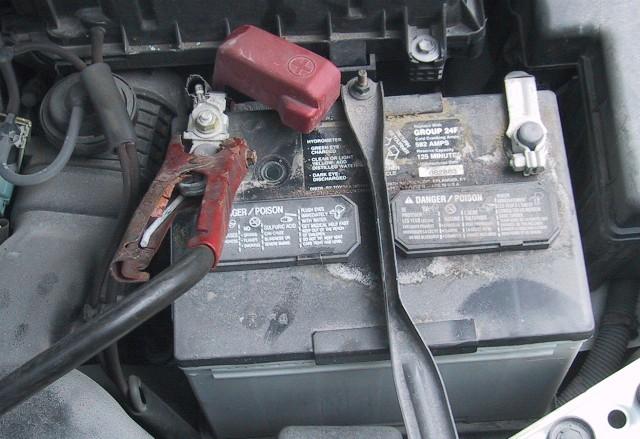If you have properly maintained the battery (and the vehicle in general), you should seldom need to remove the battery.
However, sometimes removing or at least disconnecting the battery is the only option; for instance, when you want to install a new battery, when you have a dead battery, or need to hard reset the ECU.
In any case, knowing how to disconnect a car battery is a useful skill. Here is how you can quickly and safely disconnect it.
Jump To
What You’ll Need
The car batteries in the engine bay are usually held down by a set of bolts and nuts or a single/set of clamps. Before you get started, make sure you have the following:
- A set of gloves to protect your hands from battery acid that may be on the surface of the battery
- Some sprayable lubricants (WD-40, for example) to help loosen the nuts if they are jammed tight. They can often be completely frozen if there are mineral deposits on them.
- A socket wrench set and a set of pliers
Precautions
With all your tools ready, there are a few precautions you should take to ensure you disconnect a car’s battery without any problems. These include:

https://pixabay.com/photos/working-gloves-work-gloves-handyman-3552744/
- Wearing safety gear such as gloves and glasses. Batteries can sometimes release gas, and you don’t want to get any battery water in your eyes or in direct contact with your skin.
- Working in an open space as the car, along with the battery, can release dangerous gasses.
- Leaving the driver’s side door open or at least opening a few windows in the car. With some vehicles, the car can auto-lock itself if the battery is disconnected.
- Making sure you aren’t wearing any jewelry or anything else that is conductive.
- Ensuring that you are standing on a dry surface, you’re in a dry area, and your hands and clothes are dry. The battery holds a lot of charge even when disconnected, and you don’t want any sparking due to contact with water.
- Double-checking that you have the parking brake engaged and the gear is in P (auto transmission) or in 1st gear (manual transmission).
- Keeping the car owner’s manual handy for reference on how to disconnect a car battery. It helps to be clear about a number of things, such as identifying a negative battery cable and the battery terminals.
Step-By-Step
With all your tools ready and the car in the right setup, it is time to get started with removing the battery.
Step 1
- Turn off the vehicle and remove the key from the ignition.
- Locate the battery. In most cases, the battery will be in the engine bay. Simply open the hood — you can usually identify it as the big rectangular block with a blue/black and red terminal on top of it. In the case of flooded lead-acid batteries, you may also see a line of bright-colored caps along the length of the battery. These are used to fill the battery with water.
- In some vehicles, the battery may be located in the trunk or under the rear passenger seats. In larger vehicles, the battery may be stored in a completely different location. If you can’t find the battery, consult the owner’s manual. Some vehicles also have more than 1 battery, so make sure you’re disconnecting all the batteries in the vehicle.
Step 2
- With the battery located, you want to start by disconnecting it from the negative battery terminal.
- As with nearly all batteries, the positive cable is red, and the blue/black or any other color terminal is the negative cable. You can confirm this by looking at the point on the battery; it should have a minus (-) sign on it. The other side will have a plus (+) sign.
- Some batteries have covers and caps on both their car battery terminals, so be sure to remove these first.

https://commons.wikimedia.org/wiki/File:CrocodileClamponBattery.jpg
Step 3
- With the terminals exposed, start working on undoing the clamps and disconnecting the terminals.
- First, inspect the condition of the terminals and make sure there is no rust, corrosion, or water on the terminal or the battery. If there is water, simply wipe it off with a dry cloth.
- If the car battery terminal looks relatively clean, spray on a bit of lubricant to make it easier to pull the terminals off the connector and minimize damage to the connector.
- If there is a build-up of corrosion on the terminal, make a small mixture of water and baking soda and use that to scrub the terminal until the corrosion is removed. Once the terminal is clean, apply some lubricant before you start working on it.
Step 4
- Start with the negative terminal to avoid any sparks.
- Use a socket or an adjustable wrench to get a hold of the nut and turn it counterclockwise.
- It can be a little tight, so don’t be afraid to apply force but be mindful of the terminal that it is connected to. You don’t want to break the terminal off the battery.
- You don’t have to completely remove the nut from the battery connector. You simply need to loosen it enough so that you can easily pull the connector off the terminal. You can leave the nut in the connector.
- When removing the terminals, make sure your wrench or socket does not touch both terminals simultaneously. This can cause a spark and even cause the battery to explode.
Step 5
- Repeat the same process of removing the connectors from the battery on the positive terminal.
- Once you have removed both the negative and positive terminals, make sure they don’t touch each other. It’s also a good idea not to let the positive terminal touch a metal part of the car as it can carry a residual current which causes a spark.
- The best option is to rest both terminals on a plastic surface and keep them away from each other.
Step 6
- With the battery connections undone, it is time to undo/remove the battery clamp. The battery clamp can have a nut and bolt at the top of the battery (near the terminal area) or at the base of the battery near the plate that the battery is mounted on.
- Find the nuts and bolts on the clamp and remove the clamp.
- In some vehicles, the battery may be held down by a strap. Simply undo the strap to gain access to the battery.
- Before you pick it up, keep in mind that the battery can weigh 30-80 pounds. They are quite heavy and it can be challenging to get them out if your car is tall. Also, if you have a flooded lead-acid battery (one with multiple caps/filling points on top), you want to keep the battery as level as possible when pulling it out to prevent the battery acid from moving around inside the battery. Sometimes battery acid can come out of the vent holes on top of the battery, so keep it as straight as possible.
Step 7
With the battery safely out of the area, you can address the connecting wires and the battery if you plan on reinstalling it.
The first thing to do is clean up the tray that the battery was mounted on. You may find corrosion on the tray, rust, battery acid, or just some dirt and grime.
In any case, make sure you get the tray thoroughly cleaned up so that the battery sits completely flat on it and you don’t risk damaging the bottom of it.
Secondly, look at the connectors, battery cables, and positive and negative terminals on the battery. If you see any rust or corrosion, go ahead and spray it all down with anti-corrosion spray or rub a mix of water and baking soda over all the corrosion.
Let the mixture sit for 20 minutes so the corrosion breaks free, and rub it all down with a steel wire brush to get it spick and span.
Once everything is clean, you can apply a spray lubricant or some grease to keep it clean longer, as this will prevent corrosion from building up for some time.
After Removing the Battery
If you plan on removing the battery or have already removed the battery, a few things are going to happen that you may not have expected. Luckily, these are completely normal.

https://commons.m.wikimedia.org/wiki/File:Odometer_70000.jpg
The most common change is that your trip count on the odometer will reset.
In some vehicles in which the odometer also shows service history, fuel average, trip average, and various other stats, all these things will reset. The original mileage meter on the car will remain unchanged, but nearly all the other data will be reset.
If you’ve had some error codes showing up on your odometer, those might pop up again if you manually switched them off and didn’t actually fix the issue. A battery replacement wipes the RAM on the ECU and resets the system, so you will be starting off with a fresh slate.
Conclusion
Disconnecting, removing, and even reinstalling a battery is quite straightforward but it can be challenging if the battery connections are in poor condition or if the battery is mounted in an unusual manner. If you find that your battery is leaking or bloated, it’s best to call in a professional to have a look at it for you.
Do not attempt to work on the battery or any other area in the engine bay while the engine is still hot. Give the vehicle at least 30 minutes with the hood open for it to cool off properly before you attempt any kind of repair and maintenance work.


2 thoughts on “How to Disconnect a Car Battery”
Comments are closed.